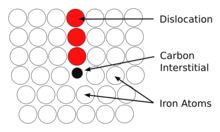Cottrell atmosphere
In materials science, the concept of the Cottrell atmosphere was introduced by Cottrell and Bilby in 1949[1] to explain how dislocations are pinned in some metals by carbon or nitrogen interstitials.

Cottrell atmospheres occur in body-centered cubic (BCC) and face-centered cubic (FCC) materials , such as iron or nickel, with small impurity atoms, such as carbon[2] or nitrogen. As these interstitial atoms distort the lattice slightly, there will be an associated residual stress field surrounding the interstitial. This stress field can be relaxed by the interstitial atom diffusing towards a dislocation, which contains a small gap at its core (as it is a more open structure), see Figure 1. Once the atom has diffused into the dislocation core the atom will stay. Typically only one interstitial atom is required per lattice plane of the dislocation.
Once a dislocation has become pinned, a small extra force is required to unpin the dislocation prior the yielding[3], producing an observed upper yield point in a stress–strain graph. After unpinning, dislocations are free to move in the crystal, which results in a subsequent lower yield point, and the material will deform in a more plastic manner.
Leaving the sample to age, by holding it at room temperature for a few hours, enables the carbon atoms to rediffuse back to dislocation cores, resulting in a return of the upper yield point.
Cottrell atmospheres lead to formation of Lüders bands and large forces for deep drawing and forming large sheets, making them a hindrance to manufacture. Some steels are designed to remove the Cottrell atmosphere effect by removing all the interstitial atoms. Steels such as interstitial free steel are decarburized and small quantities of titanium are added to remove nitrogen.
Notes
- ↑ Cottrell, A. H.; Bilby, B. A. (1949), "Dislocation Theory of Yielding and Strain Ageing of Iron", Proceedings of the Physical Society, 62 (1): 49–62, Bibcode:1949PPSA...62...49C, doi:10.1088/0370-1298/62/1/308
- ↑ Waseda, Osamu; Veiga, Roberto GA; Morthomas, Julien; Chantrenne, Patrice; Becquart, Charlotte S.; Ribeiro, Fabienne; Jelea, Andrei; Goldenstein, Helio; Perez, Michel (March 2017). "Formation of carbon Cottrell atmospheres and their effect on the stress field around an edge dislocation". Scripta Materialia. 129: 16–19. doi:10.1016/j.scriptamat.2016.09.032. ISSN 1359-6462. Retrieved 1 August 2018.
- ↑ Veiga, R.G.A.; Goldenstein, H.; Perez, M.; Becquart, C.S. (1 November 2015). "Monte Carlo and molecular dynamics simulations of screw dislocation locking by Cottrell atmospheres in low carbon Fe–C alloys". Scripta Materialia. 108: 19–22. doi:10.1016/j.scriptamat.2015.06.012. ISSN 1359-6462. Retrieved 1 August 2018.